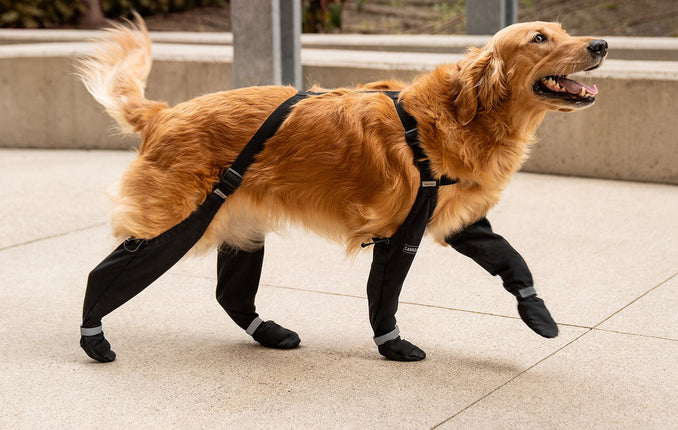
Getting Your Dog Used to Their Suspender Boots: A Step-by-Step Guide
Winter walks with your dog should be joyful, not a battle to keep their boots on. While Suspender Boots offer extra security...
When it comes to controlling and managing the movements of our beloved large dogs, the never-ending debate revolves around one question: Harness or Collar? If you're considering switching from one to the other, or you're just unsure what's right for your pup, keep reading to explore the differences.
What are the Differences Between a Harness and Collar for Large Dogs?
As a dog parent, choosing whether to use a collar or a dog harness for your pooch can seem overwhelming due to the variety in dog breeds, sizes, and behavioral patterns. In understanding the differences, it's key to consider how these tools impact the dog's body, behavior, and overall comfort.
What are the Distinct Features of a Body Harness?
A body harness typically wraps around the dog's torso and has a leash attachment spot on the back or the chest. Here, the pressure (especially when the dog pulls) is distributed across a larger surface area of the body, reducing the risk of injury.
Body harnesses come in a variety of types, including no-pull dog harnesses or front clip harnesses, which discourage pulling by training the dog to walk in line with you. Harnesses like these are favored among dog parents and trainers due to the control they offer.
How Does a Dog Collar Function Differently?
On the other hand, dog collars, which go around the dog's neck, have been a long-standing option for pet parents. It's easy to attach an ID tag to collars, and you can find them in many colors to best suit your pup’s personality. However, when a dog pulls against a collar, it creates high pressure on the throat and neck, potentially causing throat damage, especially in dogs prone to issues like a collapsed trachea.
Can Any Type of Dog Harness Be Used for Larger Dogs?
While deciding between a dog collar and a harness, it's important to know not every harness fits all dog sizes. Larger dogs may require specific types of body harnesses designed to distribute pressure evenly without hampering their mobility.
Why are Dog Parents Choosing Harnesses Over Collars?
The growing preference for dog harnesses among dog parents stems from a greater understanding of dog physiology and behavior and the concern about potential throat damage caused by collars.
How Can a Harness Prevent Throat Damage in Dogs?
Body harnesses distribute pressure more evenly across the dog's body, significantly reducing the risk of throat damage from pulling. A pull pet harness or a front-clip harness actively discourages dogs from pulling, making walks more comfortable for both the pet and the parent.
Does a No Pull Pet Harness Offer More Control for Dog Parents?
A no pull pet harness can offer a lot more control compared to a dog collar. No pull dog harnesses and front-clip harnesses redirect your dog's forward movement toward you when they pull, leading to a more manageable and secure walk.
Why Do Positive Dog Training Methods Prefer Harnesses?
Positive dog training methods focus on rewarding good behavior instead of punishing the bad. Harnesses facilitate this by discouraging pulling without causing discomfort or pain. The increase in control a harness offers also makes it a great tool in dog training.
Are There Specific Dog Breeds that Benefit More from Harnesses?
Large dog breeds such as German Shepherds, Siberian Huskies, and Labrador Retrievers can greatly benefit from body harnesses. These breeds are generally stronger and have the tendency to pull. Using a no pull dog harness can reduce risks of throat damage and provide better control during dog training or simple walks.
Which Large Dog Breeds Are More Comfortable with Harnesses?
Large dog breeds such as the Newfoundland, Saint Bernard, and Bernese Mountain Dog, known for their massive size and strength, often find dog harnesses more comfortable than collars. This is due to the design of a dog harness which distributes force evenly across the chest rather than focusing it around the neck like a collar.
Choosing the Right Leash Attachment for Your Dog Harness
If you've decided a harness is better for your large breed dog, you'll need to choose a leash attachment. Choosing the right leash attachment for your harness mainly depends on your dog's size, breed, and behavior. You should consider factors such as durability, comfort, control, safety, and purpose (for instance, regular walks, dog training, dog sports).
Conclusion
In summary, harnesses provide some clear benefits over traditional collars for most large-breed dogs. By distributing force across the torso instead of concentrating it on the delicate neck, harnesses greatly reduce the risk of throat injuries that can afflict bigger, stronger dogs who pull on leashes. The design also gives parents much better control to safely steer and easily manage large dogs on walks.
For powerful pullers, no-pull harnesses with front clip attachments can help train better leash manners through redirection. For giant breeds, the structure of a harness simply offers more comfortable walking and maneuvering. While basic collars work for some dogs, particularly those who are leash-trained already, the advantages of control and safety make harnesses the preferred option for the majority of large breed parents.
If considering a switch, just be sure any harness is specifically sized for larger dogs and fitted properly to maximize comfort and security. With the right harness matched to both parent and dog, it's possible to have stress-free walks plus a healthy, happy pet. Harnesses open up more possibilities for successful training, managing, and enjoying time with your large pup.

Winter walks with your dog should be joyful, not a battle to keep their boots on. While Suspender Boots offer extra security...

Dogs, much like their human counterparts, need protection from the elements, especially during cold and rainy and snowy seasons. Waterproof dog jackets...
When it comes to keeping your furry friend comfortable and protected during rainy or snowy days, choosing the right waterproof jacket is...